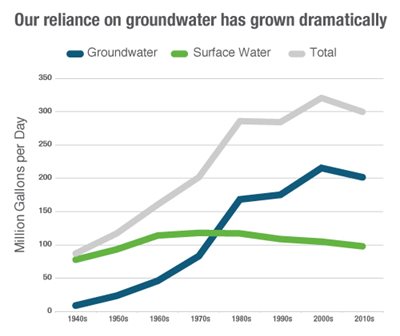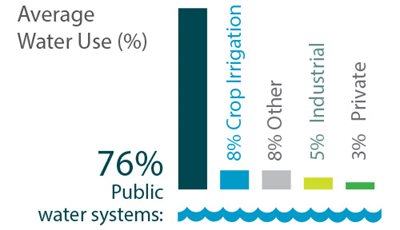It’s easy for Minnesotans to discount the likelihood that we’ll ever face a drinking water shortage.
“We’re the ‘Land of 10,000 Lakes… it’s on every license plate in the state,” New Brighton City Manager Dean Lotter said in testimony at the Metropolitan Council in February.
“I’ve seen the value of the Council and the water advisory committee firsthand, and I hope you see the link between sound water supply planning and the economic health not only of the metro area but also the Land of 10,000 Lakes.”
– Barry Stock, Savage City Administrator, in testimony to the Minnesota Legislature
But that assumption would be wrong, Lotter said. He was presenting a new report—“Water Supply Now and for the Future”—about regional water supply issues just published by the Metropolitan Area Water Supply Advisory Committee (MAWSAC), of which he is a member.
Now is the time to plan for a clean water future
Lotter said the Twin Cities has a good supply of water – and will for a long time – but new challenges will threaten the abundance of clean water if we don’t plan to sustain the resource. “A failure to plan is a plan to fail,” he said.
Illustrating the region’s key water challenges, successes
 In just six graphic-intense pages, the report outlines the sources of regional water (groundwater, rivers), how it is used (residential, business, agriculture), and how much is used (350 million gallons per day – more than average daily flow in the St. Croix River at 320 million gallons per day).
In just six graphic-intense pages, the report outlines the sources of regional water (groundwater, rivers), how it is used (residential, business, agriculture), and how much is used (350 million gallons per day – more than average daily flow in the St. Croix River at 320 million gallons per day).
Among the key water-related challenges outlined in the document are a potential 30% increase in water demand by 2040, decreasing groundwater levels, and groundwater contamination in some parts of the seven-county region.
The report also provides the framework for planning ahead to assure clean water indefinitely. Included is a five-year plan for water activities in four focus areas. The report cites a successful water conservation program in Woodbury and an innovative water-sharing partnership between Burnsville and Savage. Key elements in the work ahead are firm goals and collaboration.
Importantly, it’s not a choice between wise water use and economic growth. MAWSAC believes the region can have both by using water in smarter and more efficient ways.
Water conservation program in New Brighton slashes consumption
 In his testimony to the Council’s Environment Committee, Lotter shared results from a water conservation program in New Brighton. The program is credited in part with helping maintain a more predictable per-day pumping number: 3.2 million gallons per day (gpd) during summer when it isn’t uncommon to see daily rates between 3.5 and 5, or even 6, million gpd.
In his testimony to the Council’s Environment Committee, Lotter shared results from a water conservation program in New Brighton. The program is credited in part with helping maintain a more predictable per-day pumping number: 3.2 million gallons per day (gpd) during summer when it isn’t uncommon to see daily rates between 3.5 and 5, or even 6, million gpd.
The report proposes a regional goal to reduce the average daily water consumption from 125 gallons per day per person to 90 gallons per day, a 30% reduction.
“By reaching that goal, our region could grow by almost 800,000 people without increasing water use above today’s total,” he said. “It can be done.”
Council Members Sandi Rummel, Wendy Wulff and Edward Reynoso were gratified to hear the testimony. “It’s a great conversation to have right now,” Reynoso said, adding that water is everyone’s business. “It goes across party lines.”
Water Supply Advisory Committee instrumental in long-range water plans
MAWSAC was created by the state legislature in 2005 to help the Metropolitan Council address long-range water supply in the Twin Cities metro area. MAWSAC adopted the first Master Water Supply Plan in 2010 and updated it in 2015.
In 2016, MAWSAC appointed a new 15-member Water Supply Technical Advisory Committee to provide scientific and engineering expertise to inform MAWSAC’s work.
Results from work by MAWSAC and its technical advisory committee are clear.
Before MAWSAC:
-
No overall regional master water supply plan
-
No collaboration by local governments while updating their individual water supply plans
-
No tool to evaluate the long-term effects on groundwater supply of each individual user
-
No regionwide awareness of water supply issues or potential remedies
Under MAWSAC:
-
A Master Water Supply Plan
-
Collaboration among regional agencies and stakeholders
-
A common base of technical information
-
Support for water efficiency through grants, technical assistance and more
Legislators hear testimony about Council’s important role
At the Capitol, legislators recently heard a strong and supportive testimonial about the Council’s work in water supply planning from Savage City Administrator Barry Stock, who is the longest-serving member of the Metro Area Water Supply Advisory Committee.
In talking about the importance of long-range planning, Stock said, “I’m pretty sure that Flint, Michigan, thought they had things under control before everything turned upside down.”
Stock credited the Metropolitan Council not only with regional leadership on the issue but also for its technical and staff support to the water advisory committee. “It’s important that the Metropolitan Council continue to play a role in assisting communities with water supply planning,” he said.
“I’ve seen the value of the Council and the water advisory committee first hand, and I hope you see the link between sound water supply planning and the economic health not only of the metro area but also the Land of 10,000 Lakes.”
More information